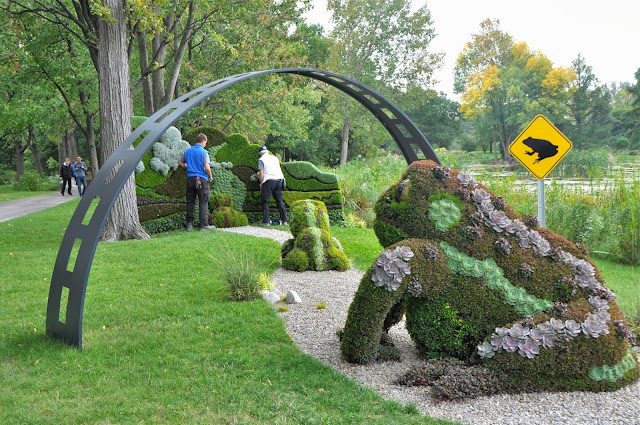As a P.S. to this post at the beginning - for whatever reason, the links to recipes on my BITE page are no longer active. I'm not sure when or why this happened, but will try to address is as soon as I can - sorry about that!
While compiling pictures for this post, I realized that I should have planned on four posts of this event rather than three. Please forgive how long this one is - some of the creations can simply not be shown with one photo - I think you will see why! Caption information for today's post, as well as last Wednesday's come from the signs alongside each display.
It often felt as though we were walking through an enchanted forest!
"The Boars of Sally Island" Sally Matthews created this display, using her love of animals as her inspiration. She desired to create and impart life and motion to her five boars using dead plant matter found on the site.
"The Boars of Sally Island"
"The Boars of Sally Island"
I'm sorry to say that I do not have the stories that accompany the photo above and the two below. I have no doubt that they are grand!
"Hope and Odyssey" While not strictly a mosaiculture piece, this represents a new trend of so-called ecological works, made from organic materials and inspired by nature.
"The Uffington White Horse" With a length of 123 meters, the "White Horse of Uffington" stretches out below the ruins of Uffintgon Castle in Oxfordshire, England. A recent analysis of the actual structure puts its creation at about 1,000 B.C.
"Sharing the Riches of the Land"
"Sharing the Riches of the Land"
"Born with the Sun" Here, father-bird pays tribute to the universe, while mother-bear sows seeds of Earth's future. They do this for their child, who will thereby remember his roots and grow up in harmony with all his kin.
"Mother Earth" A perfect example of how one photo simply cannot do it justice. Mother Earth, as named and celebrated by North America's First Nations - she is universal and transcends nationalities and ages. She is the basis for everything: living beings, plant life, minerals, textiles, technology, food.
"We are part of the Earth and it is part of us. The perfumed flowers are our sisters, the deer, the horse, the great eagle, these are our brothers. The rocky crests, the juices in the meadows, the body heat of the pony, and man, all belong to the same family."
"Mother Earth"
"Mother Earth"
"Mother Earth"
"Mother Earth"
"Swan Song" The swan represents Finland, the country's national bird. Evoking grace, elegance and beauty, the swan is also a symbol of the fragility of life on this planet.
"Butterfly" The first-ever figurative mosaiculture piece, this is credited to one Mr. Comesse, a gardener whose inspiration came from his drawing resembling a paint-by-numbers canvas. It is comprised of 3,000 individual plants.
"Butterfly"
"Hands Up!" Borneo, with its great biodiversity, is home to 1,000 different animals species, including the orangutan. The word "orangutan" comes from the Malay and Indonesian languages meaning "man of the forest".
"Gorillas at Risk" In the southwest part of Uganda lives the only population of mountain gorillas in the world, with no more that 800 individuals. They, along with all species and sub-species of gorillas are either endangered, or critically endangered.
"Practically Family" Chimpanzee populations are declining everywhere. Thankfully, efforts have been made to reverse this.
"Ambassadors of Hope"The giant panda is perhaps the world's most powerful symbol of species conservation.
"One Small Bridge for Mankind, One Giant Leap for Biodiversity" Through cohabitation with the natural environment and their actions, humans generate an interrelationship between themselves and the surrounding nature to preserve the vital, yet fragile biodiversity of their environment and foster harmony among the various ecosystems.
"Gypsy or Gaia?" Gypsy or Goddess of the Earth?
"Sunbath"
"Planting Plane Trees to Attract the Phoenix" In Chinese legend, the Phoenix is the king of birds. People today still consider it the bearer of happiness and a symbol of peace and harmony.
"Small Clownfish and Anemone"
"Title Unknown - sorry!"
"The Bird Tree" This structure was more than six years in planning and creation, and weighs nearly 100 tons. It is just awesome - that's the best way for me to describe it! The Bird Tree's branches transform themselves into 56 birds species, while its roots change into a Kakaps and six species of amphibians and reptiles.
"The Bird Tree"
"The Bird Tree"
"The Bird Tree"
"The Bird Tree"
"The Bird Tree"
While I have a few more generic Botanical Garden pictures, I will end here. Thanks for hanging on till the end of this post - I know it's long! I have no idea when Mosiaculture will return to Montreal - it has been 10 years since it was here last! I'm just so happy that we had the opportunity to see it!
On Wednesday I will share the shots of flowers - an amazing array for so late in the season!


























































